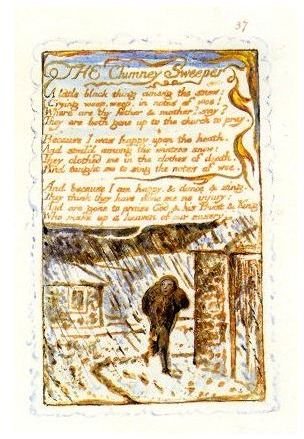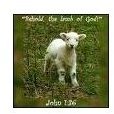Poetry Analysis of "The Chimney Sweeper" & "The Lamb" by William Blake
How to Analyze Poetry
Before we begin interpreting William Blake’s Poetry, let’s review how to do a poetry analysis.
- Print out the poem. Most poems can be found online. If you have a book you’re allowed to write in, then write in it.
- Annotate the poemusing the following steps:
- identify the rhyme scheme
- identify the meter and any examples of straying from the meter
- if the poem is difficult, summarize each stanza
- circle important words, ambiguous words, and words you need to look up
- circle examples of figurative language
- write questions
- write insights.
- Draw conclusions based on the information you gathered while annotating.
- Write the poem analysis.
- The topic sentence should state the poem’s theme (one that may not be so obvious).
- The examples, facts, citations from the poem you’re analyzing should support the topic sentence.
- Provide analysis explaining how your facts support the topic sentence.
- Impress your friends and neighbors.
An Analysis of “The Lamb” by William Blake
- An analysis of “The Lamb” by WIlliam Blake begins by printing the poem. It can be found here. Print it out and take notes.
- Rhyme Scheme - aabbccddeeaa aabcddcbaa - the couplets combined with short line lengths and the repetition of the first two and last two lines of each stanza produce a songlike quality to the poem. The poetic form reflects the content, a simple, yet profound question asked to a child.
- The first stanza contains a question to a child. The second stanza gives the answer.
- The first stanza contains a metaphor comparing the child to a lamb. The second stanza contains a metaphor comparing lamb to Jesus Christ. Lamb in the second stanza is also a Biblical allusion. Thee is repeated at the end of eight lines in the poem. The first two lines repeat. The last two lines of the first stanza repeat. The first two and last two lines repeat respectively. Why? There is a progression. The first stanza presents the question “Who made thee?” The first two lines of the second stanza brings good news, being I know the answer and “I’ll tell thee.” The next six lines express that the Lamb of God made him, which leads to the poem’s speaker’s joyous exclamation of “God bless thee!”
- Stanza 1 contains the pastoral images of stream, vales, and mead and paints an ideal picture of infancy– “clothing of delight,” “wooly bright,” “tender voice.”
- Stanza 2 contains a religious-philosophical discussion on human creation.
Sample Paragraphs

There’s my interpretation of the poem, all written out nice and neat. Save your disagreements for the comment section:
“The Lamb” by William Blake provides a simple and profound answer to a simple and profound question: Who made us? (the topic sentence states the title and author of the poem as well as the poem’s theme). Because the poem addresses a child it takes on the form of a child’s song, containing rhymed couplets and repetition (we’ve taken a fact about the poem and explained the significance of the fact to the poem’s overall meaning). Because the poem addresses a child, the answer to the question must be at the level a child can understand. In this case, the Lamb–meaning the Lamb of God, made thee, isn’t that great? (this is the simple answer alluded to in the topic sentence).
The answer, although understood by the child, deals with a philosophical religious question that scholars have discussed for centuries (this addresses the profound answer mentioned in the topic sentence), leading one to think that perhaps we all need to become like a little child to understand our eternal nature (note how the author of this paragraph adds a Biblical allusion and ends his paragraph by restating the poem’s theme and tying it into his topic sentence).
An analysis of “The Lamb” by William Blake from cannot be fully understood without addressing “The Tyger,” the companion poem found in Songs of Experience. Clicke the link for a full analysis to that poem.
“The Chimney Sweeper”
Blake wrote two “Chimney Sweeper” poems–one for Songs of Innocence and one for Songs of Experience. We’ll begin analyzing “The Chimney Sweeper” by William Blake from Songs of Innocence.
- Rhyme Scheme = aabb and contains near rhyme in stanzas four and five, drawing attention to wind, a symbol of freedom, and work, the means to access it. The use of rhyming couplets resembles that of a nursery rhyme.
- Meter - most lines contain four metrical feet with varying stress patterns including both iambic and anapestic (two short syllables followed by a long one).
- Lines 5 and 6 contain a simile comparing Tom Dacre’s hair to lambs wool. Lamb is a symbol of innocence. Line 8 contains a contrast of white hair (angelic) and soot (sin). Note that the soot cannot spoil the hair.
- The fourth stanza mentions the unlocking of coffins by an angel and being washed clean in a river. These are Christian allusions to Christ’s resurrection and baptism. The beginning of the fifth stanza mentions the boys in the dream were “naked and white, all their bags left behind.” Naked and white suggests innocence and purity. Baggage denotes sin and the cares of the world.
- The last stanza shows the effects on Tom. He is a child of innocence and purity, though working in a field that wearies him.
- Theme: This poem offers sharp criticism of the child labor that was common at the time. A child should be learning and playing, not working in a labor-intensive career.
Part II

From <em>Songs of Experience</em>
- Rhyme Scheme = abab abab abab
- The first line of the poem contains a contrast within itself and a contrast with the version of the poem in Songs of Innocence. In Songs of Innocence, the dirt could not hurt the innocent child. In Songs of Experience, the “little black thing” is the focal point. The chimney sweeper cries “notes of woe,” a contrast to “scarcely crying weep! weep! weep! weep!”
- The first stanza contains the following contrast: the chimney sweeper is working and covered in soot while mother and father have gone to church to pray. The chimney sweeper symbolizes the plight of England’s children (chimney sweeper was a horrible job done by children because they were small enough to fit in the chimney and clean it). Fathers and mothers symbolizes those responsible for taking care of children, be it the church, the king, or adults in general.
- The second stanza is a metaphor for taking a child from innocence “happy upon the heath” to a life of misery, “clothes of death.” He’s gone from “winters snow” to “notes of woe.”
- The third stanza denounces the hypocrisy of the upper classes for praising “God & Priest & King” while ruining the lives of children.
- Theme - Those who allow children to live as miserable chimney sweepers are nothing more than hypocrites.
This post is part of the series: Romantic Poets: Blake and Wordsworth
Romanticism refers to a literary movement that began in late eighteenth-century in England. It does not refer to the movement of your hands from the steering wheel to your girlfriends shoulder last Friday.
- Interpreting William Blake’s Poetry: “The Lamb” and “The Chimney Sweeper”
- Analysis of “The Tyger” by William Blake
- ‘I Wandered Lonely as a Cloud’: A William Wordsworth Poetry Analysis
- Important Quotes From William Blake’s Poems
- British Romanticism: Poem Examples
